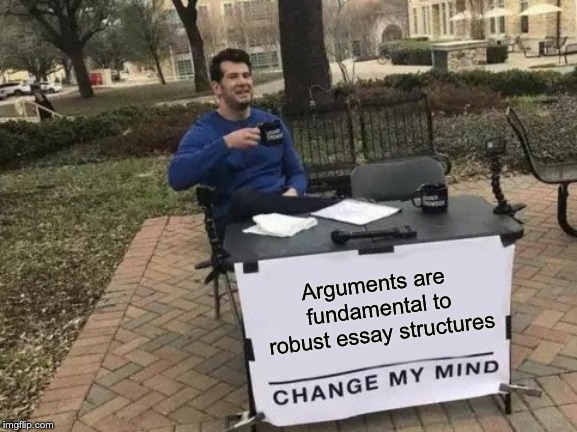
What is an Academic Argument?
We all know what an argument is, right? You probably grew up arguing with your siblings about which television shows to watch, or with our friends about which football team is best.
But when it comes to an academic argument, we’re doing something quite specific. An academic argument is not necessarily about a disagreement, or a series of contradictions. When making an academic argument, we put forward a claim and attempt to justify that claim with a series of connected premises that are supported by evidence.
So, really, we can break down an academic argument into a simple formula: claim + premises + evidence = argument.
Your job in an academic argument is to persuade your reader to believe what you are asserting. This means you can’t just describe things or list facts. Plus, a claim on its own is not an argument. You must develop an argument by putting forward connected key points that will support your claim. This means our argument is made up of:
- A claim or hypothesis (thesis statement)
- One or more supporting statements (referred to as premises)
- Evidence for your supporting statements

Claim
Your claim is basically your argument in a sentence – a specific response to the question that shows the reader your position. It might seem a bit backwards to think of it this way, but your claim is also your conclusion. It is what you want your reader to understand, or be convinced of, by the end of your essay.
Your claim, therefore, must be specific, relevant, and reasonable. For example, your essay question might read: ‘What is one way governments can create positive and equitable social change?’
Your claim might respond: ‘One way the government can create positive and equitable change is to pay for university students’ education.’

Premises
As your goal is to convince your reader to accept your claim by the end of your essay, your argument is really only as strong as its supporting premises. These are specific and evidence-based points that help support your argument. You might be more comfortable or familiar with referring to these as your key points.
Each premise must logically develop and further your argument. It must also provide reasons that convince the reader to accept your claim. For example:
Claim: ‘The government should pay for university students’ education’.
Premise 1: ‘Because students’ education benefits the whole community’
Premise 2: ‘Because education allows for social and economic mobility which alleviate poverty’
Premise 3: ‘Because education leads to a more productive workforce’
Or, you might have one main premise that supports your claim and is broken down into different parts that make up your key points.
Bringing the claim and premises together is where we get our typical essay structure: the claim is outlined in the introduction and supported by three to four key points/premises that make up our body paragraphs, which are synthesised to consolidate the argument in the conclusion (and I’ll talk more about essay structures next week!)
We can indicate the difference between our claim and premises by using specific language. Words like ‘therefore’, ‘thus’, ‘hence’, and ‘consequently’ indicate a conclusion/claim. Words like ‘because’, ‘since’, ‘supporting that’, and ‘given that’ indicate a premise.
What makes a strong argument?
A good argument contains a few important things:
- The premise must be acceptable or reasonable (likely to be true)
- The evidence must be relevant to the claim
- The reasons must provide sufficient grounds to lead us to accept the claim
This seems straight forward, right? But there’s a few more elements that we can look at to ensure that we are doing these three key things.
Have a clear thesis statement
Your thesis statement is essentially, your argument in a sentence. It tells your reader your specific approach to the question and provides something of a roadmap for your essay. Your thesis statement will appear in the introduction to your essay, and will be either preceded or followed by the supporting key points. If you struggle with constructing a thesis statement, try turning the essay question into an answer.
Your thesis statement should also be very clearly defined, and specific enough to answer the question within the scope of the essay, and not so vague that your reader won’t get an idea of how you are approaching the topic. Remember to bring it back to what you are doing. Your tutor might be reading dozens of essays. How will your thesis statement define how you, and not anyone else, has approached it?
So if we return to our earlier question: ‘What is one way governments can create positive and equitable social change?’
We might have a thesis statement that says: ‘Paying for students’ education is one way governments can create equitable social change, as education benefits the whole community, allows for social and economic mobility, and leads to a productive workforce.’
See how this thesis statement directly answers the question, telling the reader one thing governments can do – in this case, pay for education. It also tells the reader the three premises, or key ideas, that will support this argument.
Have relevant and significant key supporting premises
It’s important not just to choose the right supporting premises, but to ensure they are relevant, connected to one another, and presented in the most logical order.
If you’ve done some brainstorming in the planning stages (read my posts Analysing the Task and Planning and Outlining if you haven’t) you may have quite a few potential key points that you could cover in your essay. Remember, you can’t necessarily do everything! Your reader knows that you have a limited scope, and so your job is to choose the most important and most relevant points that will make your argument the strongest.
Once you know the order of your supporting premises, each individual will then need to be developed sufficiently on its own. We break each of our premises into its own paragraph, and begin with a topic sentence. This is a bit like a mini-thesis statement in that it succinctly tells the reader the content of the paragraph. For example: ‘Higher education has benefits not just for students, but for the entire community.’

Develop each premise logically and deeply
Your job is then to develop that premise sufficiently. This means supporting your points with evidence and showing logical links between ideas. Here’s where we get into critical thinking and analysis. You need to show that your premises are valid, which means explaining why something is the case, or explaining how something occurs. Don’t simply describe – justify! To do this, use terms such as:
- Because of…, Given that…, Not only… But also …, Since…, If… Then…, Due to…, Thus…, It follows that….
To effectively integrate evidence and supporting points into your argument, use terms such as:
- According to …, Smith states …, This is supported by …, Research findings by Smith indicate that …
You can add more supporting points to an argument by using:
- Consequently…, Furthermore …, In support …, Additionally …, This implies that …, This extends this idea by …
And you can introduce an opposing idea, or show disagreement, by using:
- Despite this …, However …, Whereas …, Yet …, Contrary to …, Although …, Nevertheless …
Within each supporting point, you must include evidence, acknowledge counter arguments (if applicable), draw out the implications (why is this significant? What does it really mean?), and lead each point toward the conclusion. And finally, while each key point may be made up of several supporting ideas/evidence, it is important to ensure that each is clearly connected to that single, central premise. This will aid in clarity and direction through the essay, and allow you to synthesise ideas effectively.
Use credible evidence to support your points
If an argument is only as strong as its supporting premises, premises are only as strong as their evidence! If one premise is seen to be invalid, or is not sufficiently backed up, your entire argument can fall apart.
When looking for evidence, it’s really important to refer not only to those we deem reliable – our peer review articles, academic books, and government and official websites – but to ensure that we use the most relevant, specific and up to date evidence. The more you can link evidence to the exact context you require, the more convincing your argument will be.
Also, make clear links between your ideas and evidence. You need to ensure that your reader understands why this piece of evidence best exemplifies your point. Your reader is not in your head, and sometimes you need to provide context for them to understand how theory and examples or evidence are connected to each other. Don’t simply present a statement and a piece of evidence side by side. Their relevance to one another may not be as obvious as you think it is!

Some Common Problems
Because academic arguments are not merely about agreement or disagreement, you may not necessarily recognise what you’re doing when responding to an essay question as presenting an argument. Plus, a lot of the time, your essay instructions may not even mention the word ‘argument’. This is made more difficult because we’re often told at university that we must remain objective, and cannot express our own opinions. The thing about arguments, though, is that they essentially are an opinion. You are being asked to take a position on an issue, and that necessarily requires you to take sides. The difference is that an academic argument takes that opinion as a starting point and then develops it logically, persuasively and with reference to strong supporting evidence.
Also, you may feel uncomfortable making an argument because you think your instructor wants to see a specific ‘correct’ answer. Sometimes there are straightforward answers, particularly in more simple argumentative essays such as ‘why is hand hygiene important for nurses?’ In this case, we can take it for granted that yes, hand hygiene is important, and we simply need to argue why. But sometimes there simply isn’t a single ‘correct’ answer, and your response could approach a subject from a potentially huge spectrum of positions. What is more important is that regardless of whatever position you take, you use your critical thinking and analytical skills to present a convincing, logical and well-developed argument (even if you think your tutor might disagree with your position!)
So, if we have all of these elements, we should have a clear, logically developed and reasonable argument that will convince our reader that our claim is true and valid. It also means that we’ll be able to construct a clear, comprehensive, and logical essay structure! More about that next post!

